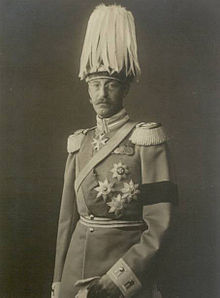Mindaugas II
| Wilhelm Karl | |||||
|---|---|---|---|---|---|
 |
|||||
| Duke of Urach | |||||
| Reign | 17 July 1869 – 24 March 1928 | ||||
| Predecessor | Prince Wilhelm | ||||
| Successor | Prince Karl Gero | ||||
| King-elect of Lithuania | |||||
| Reign | 11 July – 2 November 1918 | ||||
| Born |
30 May 1864 Monaco |
||||
| Died | 24 March 1928 (aged 63) Rapallo, Kingdom of Italy |
||||
| Burial | Ludwigsburg Palace Church | ||||
| Spouse | Duchess Amalie in Bavaria Princess Wiltrud of Bavaria |
||||
| Issue | Princess Marie-Gabriele Princess Elizabeth Princess Karola Prince Wilhelm Karl Gero, Duke of Urach Princess Margarete Prince Albrecht Prince Eberhard Princess Mechtilde |
||||
|
|||||
| House | Württemberg | ||||
| Father | Wilhelm, 1st Duke of Urach | ||||
| Mother | Princess Florestine of Monaco | ||||
| Full name | |
|---|---|
| Wilhelm Karl Florestan Gero Crescentius |
Prince Wilhelm of Urach, Count of Württemberg, 2nd Duke of Urach (Wilhelm Karl Florestan Gero Crescentius; German Fürst Wilhelm von Urach, Graf von Württemberg, 2. Herzog von Urach; 30 May 1864 – 24 March 1928), was a German prince who was elected in June 1918 as King of Lithuania, with the regnal name of Mindaugas II. He never assumed the crown, however, as German authorities declared the election invalid; the invitation was withdrawn in November 1918. From 17 July 1869 until his death, he was the head of the morganatic Urach branch of the House of Württemberg.
Born as Wilhelm Karl Florestan Gero Crescentius, Count of Württemberg, he was the elder son of Wilhelm, 1st Duke of Urach (the head of a morganatic branch of the Royal House of the Kingdom of Württemberg), and his second wife, Princess Florestine of Monaco, occasional acting Regent of Monaco and daughter of Florestan I, Prince of Monaco.
At the age of four, Wilhelm succeeded his father as Duke of Urach. He was born and spent much of his childhood in Monaco, where his mother Florestine often managed the government during the extended oceanographic expeditions of her nephew, Prince Albert I. Wilhelm was culturally francophone.
Through his mother, Wilhelm was a legitimate heir to the throne of Monaco. Wilhelm's cousin Prince Albert I of Monaco had only one son, Louis, who was unmarried and had no legitimate children. The French Republic, however, was reluctant to see a German prince ruling Monaco. Under French pressure, Monaco passed a law in 1911 recognising Louis's illegitimate daughter, Charlotte, as heir; she was adopted in 1918 by her grandfather Prince Albert I as part of the Monaco Succession Crisis of 1918. Wilhelm was relegated to third in line to Monaco's throne, behind Louis and Charlotte. Furthermore, in July 1918 France and Monaco signed the Franco-Monegasque Treaty; it required all future princes of Monaco to be French or Monegasque citizens and secure the approval the French government to succeed to the throne. After the accession of Prince Louis II in 1922, Wilhelm renounced his rights of succession to the throne of Monaco in favour of distant French cousins, the counts de Chabrillan, in 1924.
...
Wikipedia
